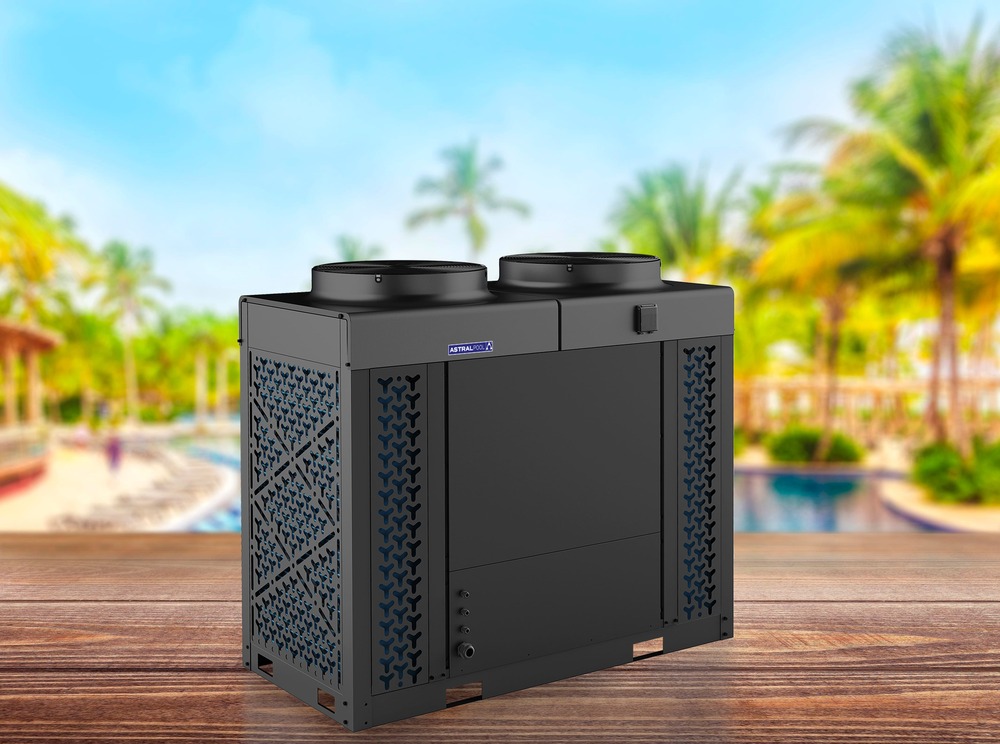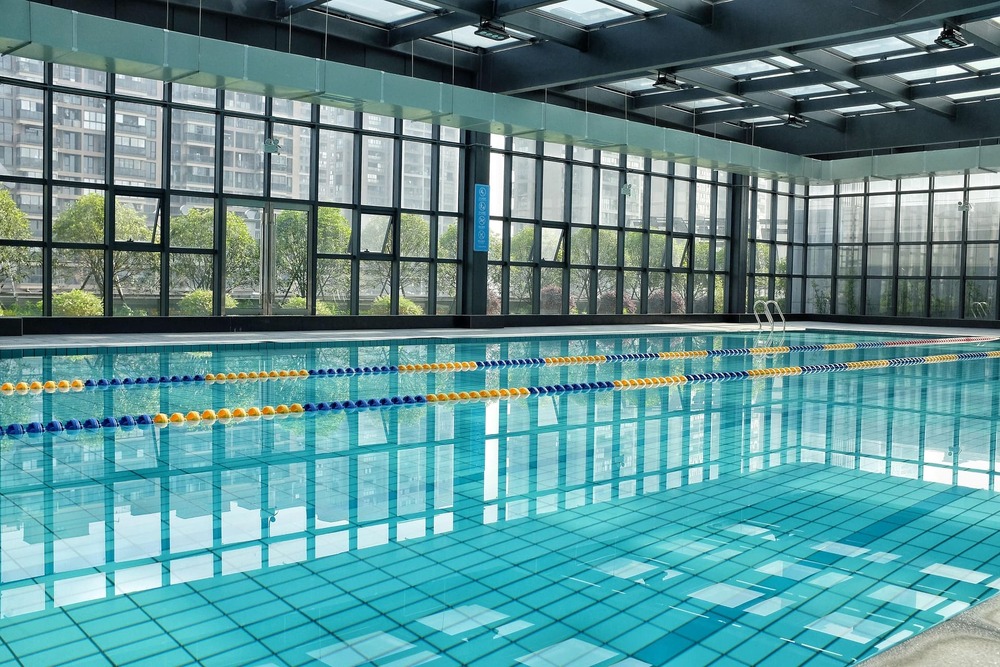Today, swimming pool heat pumps have become the standard solution for maintaining optimal water temperature in aquatic facilities, whether they are commercial or residential.
Today, pool cooling and heating systems are at the heart of efficient pool installations. In this context, picking the ideal heat pump for your pool means taking some core factors into account (the size of the pool, the purpose and intensity of use, its geographical location, if it’s an outdoor or indoor pool…) while also ensuring efficiency and sustainability are a priority.
Understanding this equipment’s technical aspects and operational needs ensures all pool professionals have access to the best selection criteria for making informed decisions and providing expert guidance.
In other articles, we’ve taken a bird’s eye look at the available pool heating options today. Today, we focus on providing a comprehensive guide to understand heat pumps for swimming pools, including some vital selection criteria on how to pick the right one for your project.
Dive deeper with the eBook
Understanding swimming pool heat pumps
Heat pumps operate on this fundamental thermodynamic principle: heat transfer from a source (ambient air) to a destination (pool water). This process involves a closed refrigeration cycle that efficiently extracts thermal energy from the surrounding environment.
This system comprises several key components working in harmony to maintain desired water temperatures. The primary components include an evaporator that absorbs heat from ambient air, a compressor that pressurizes the refrigerant gas, a condenser that transfers heat to the pool water, and an expansion valve that regulates the refrigerant flow. Together, these elements work in a continuous cycle that is at the heart of heat pumps’ reliable and efficient heating.
Additionally, modern pool heat pumps incorporate advanced materials and design features that enhance their durability and performance:
- Titanium heat exchangers offer superior corrosion resistance and longevity when exposed to treated pool water, while also ensuring maximum heat transfer.
- Because the fan system must be properly sized to ensure adequate airflow across the evaporator, modern units feature variable-speed fans that optimize performance while also minimizing noise levels.
- Scroll or rotary types of compressors are selected for their reliability and efficiency.
- Advanced evaporator’s design includes specially coated fins that enhance heat absorption and resist corrosion.
This unique combination of an efficiency-based process and technological advancements have translated into heat pumps becoming a staple of sustainable heating technologies. In fact, organizations such as the European Commission describe heat pumps as “key to enabling the clean energy transition and achieving the EU’s carbon neutrality goal by 2050.”

How do swimming pool heat pumps work? The heat transfer process
The process begins when the fan draws ambient air across the evaporator coil. The refrigerant inside the evaporator absorbs heat from this air, causing it to change from a liquid to a gaseous state. This gas then enters the compressor, where it’s pressurized, significantly increasing its temperature.
The heated, high-pressure refrigerant flows through the condenser, where it transfers its heat to the pool water circulating through the heat exchanger. As the refrigerant cools, it returns to a liquid state and passes through the expansion valve, where the cycle begins anew.
Types of swimming pool heat pumps
Standard heat pumps operate on a fixed-speed compressor system, cycling on and off to maintain desired temperatures. These units are robust and reliable but may experience higher energy consumption during startup cycles.
Inverter technology, by contrast, allows the compressor to operate at variable speeds, adjusting output based on demand. This results in a number of benefits related to this type of heat pump, including:
- Enhanced efficiency through reduced cycling and optimized performance.
- Lower operating costs due to precise temperature control.
- Extended equipment life from reduced mechanical stress.
- Quieter operation, particularly during low-demand periods.
Indoor vs. outdoor applications
The space where the heat pump will be installed dictates a number of requirements.
On the one hand, indoor pool installations require careful consideration of ventilation and space requirements: the heat pump must have adequate airflow, and proper condensate management is crucial, while also maintaining appropriate noise levels for the enclosed environment.
On the other hand, outdoor installations face different challenges, including weather protection and seasonal performance variations. In other words, units must be designed to withstand environmental exposure while maintaining efficient operation across varying ambient conditions.

How to pick the right swimming pool heat pump?
Accurate heat pump sizing is crucial for efficiency, and it begins with precise pool volume calculations. The total water volume serves as the baseline for heat pump capacity requirements. Surface area and average depth measurements must be precise to ensure proper equipment selection.
Additionally, heat loss calculations must account for factors such as wind exposure, humidity levels, and desired temperature rise. Professional calculations should consider both steady-state operation and initial heating requirements.
On top of these calculations, the sizing process must also account for peak demand periods and recovery times, and temperature maintenance requirements must consider variations between different facility types.
Finally, environmental factors should be taken into account, as geographic location significantly impacts heat pump performance and selection. Ambient air temperature, humidity levels, and seasonal variations all affect the system’s coefficient of performance (COP), but units must be sized to maintain efficient operation even during periods of lower ambient temperatures.
All in all, to define a heating system suitable for a pool, the most important parameters are the ones below:
- Average outdoor air temperature (°C)
- Pool water target temperature (in °C)
- Period of use
- Pool volume (m3)
- Presence of an isothermal cover or not
- Filtration time
The 4 efficiency keys you should know about heat pumps
1. Coefficient of Performance (COP)
The COP represents the ratio of heat output to electrical energy input, and should be a key selection criteria for picking the right swimming pool heat pump. Most modern heat pumps typically achieve COPs ranging from 5 to 7 under optimal conditions, which means they produce 5 to 7 units of heat energy for each unit of electrical energy consumed.
In order to obtain precise COP values, performance metrics should be evaluated under real-world conditions rather than solely relying on manufacturer ratings, with the key factors affecting COP including:
- Ambient air temperature and its impact on heat transfer efficiency.
- Water temperature differential between inlet and outlet.
- Operating conditions including humidity and airflow.
- System maintenance status and component condition.
2. Operating costs
The long-term cost analysis also represents a key aspect of understanding swimming pool heat pumps and their efficiency. A comprehensive cost analysis includes aspects such as energy consumption patterns, local utility rates, and maintenance requirements. This way, the initial investment costs can be weighed against operational savings over the equipment’s expected lifespan, with regular monitoring of performance metrics helping in identifying efficiency degradation early.
3. Installation requirements
Proper installation will be key to ensure top efficiencies from heat pumps. This requires careful attention to aspects such as:
- Location planning, which should consider airflow requirements and service access, as well as minimum clearance and acoustic considerations
- Hydraulic integration with existing pool circulation systems.
- Electrical infrastructure including proper sizing of power supply.
- Condensate management systems and drainage provisions.
On top of this criteria for optimal performance, installation should comply with local building codes and safety regulations.
4. Maintenance protocols
Finally, comprehensive maintenance programs lie at the heart of guaranteeing maximum efficiency from heat pumps on the short, medium and long-term. In fact, documenting maintenance activities and performance data is key to tracking the system’s health and predicting all potential issues.
- Regular inspection of critical components.
- Cleaning of air coils and water strainers.
- Monitoring of refrigerant pressures and temperatures.
- Verification of safety and control system operation.

Top efficiencies and sustainability: the case for swimming pool heat pumps
Today, swimming pool heat pumps are generally praised as the most efficient and environmentally responsible solution for pool heating applications. A feat that is due to their unique combination of energy efficiency, reliable operation, and advanced control capabilities.
But that’s not the full story: heat pumps are also benefiting from the continued evolution of heat pump technology, particularly in areas such as efficiency and control systems. For instance, technological advancements are being made to develop cold-climate heat pumps that are capable of increasingly higher COP values.
On top of this, government incentives continue recognizing these systems as a sustainable choice, and providing funding and other benefits in order to make them accessible to a broader range of installations.
As seen above, success in heat pump implementation depends on three fundamental aspects: proper sizing, installation, and maintenance. At Fluidra, we help pool operators achieve just that, accessing long-term benefits for their facilities both in terms of operational costs and system reliability.
As such, we help you pick the right top quality heat pumps that will extend your equipment’s life value and reduce costs while ensuring the best swimming pool temperatures.
